Glasgow: rum and slavery
As part of this week’s look at rum and in anticipation of the first Scottish Rum Festival, a look at the forgotten story of Glasgow’s rum history
How many times did I walk along Jamaica Street, and over Jamaica Bridge before I made the connection between Glasgow’s street names and slavery? Glasgow, we were told at school, became rich on the tobacco trade. Slavery? That was an English thing. There was no mention of how the tobacco was harvested, nothing said of the labour which made Glasgow a major centre for the sugar and rum trade. We knew how it was drunk, but nothing of how the cane was cut. Secrets, lost stories, and tales which could never be told.
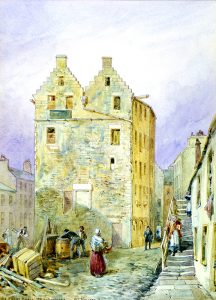
Here’s a wee Glasgow tour for you. Start in the Merchant City, Candleriggs to be precise. This is where in 1667 Peter Gemmill, John Cauldwell, Frederick Hamilton and Robert Cumming started to refine sugar in their Wester Sugar House. A dozen years later, they started to distil rum.
Head east, down to the Trongate where the sugar exchange within the Tontines building once stood. Keep going east, past the Saracen’s Head to 138 Gallowgate. This is where, in 1669, the Easter Sugar House sat. By 1680, it had begun to make rum and was the sole distiller for a decade.
Now go towards the Clyde and Stockwell Street where, in 1700, Daniel and Matthew Campbell started a ‘distillerie manufactoire’ otherwise known as the South Sugar House. In 1736, it was sold in to Maj. James Milliken and Capt. William McDowall plantation owners on St.Kitts. With Alexander Houston they became the largest sugar merchants in Scotland until the business collapsed in 1800.
While there was a contemporaneous ‘suggar work …and a sullarie for distilling of Rhum’ in Leith, Glasgow was the centre of the sugar and rum trade which took over from tobacco after the American War of Independence.
You can see that shift through the volume of rum being made at the three sugar houses which by 1684, was claimed to be hard to discern from ‘the fynnest of the forraigne Brandie.’ Most of this was consumed in Glasgow and Edinburgh, but some also Highlands, Hebrides and exports to England.
By 1715, historian T.C. Smout suggests distilling may have taken over from sugar making as the main activity.
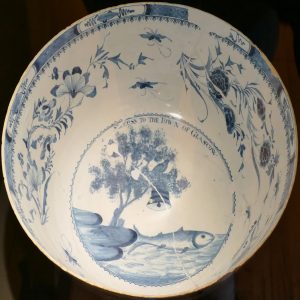
The rise in sugar imports also brought more rum into Glasgow. This was the era of punch, with endless bowls being fathomed to the toast ‘The Trade of Glasgow and the Outward Bound’.
By the end of the 18th century, the city had a flourishing clubland, centred around Argyle Street and Glasgow Cross. According to John Strang’s 1857 ‘Glasgow And Its Clubs,’ a ‘remarkable turtle feast’ took place at the Gaelic Club on 18th July 1799 with no-one rising from the table until ‘the whole was washed down with many hours uninterrupted flow of that universal beverage yclept Glasgow Punch manufactured of the best rum, lemons and limes…’
Clubs such as The Gaelic, the Pig Club, and the Board of Green Cloth were where the sugar merchants met, did business, cajoled politicians and made connections.
My Lord Ross’s Club, founded in 1780, met in a High Street tavern to eat rabbits and drink Jamaica rum and “tippeny” (two pence a pint) ale. Members of the Grog Club gathered in the Black Boy Tavern in Gallowgate to drink diluted Navy rum.
A tin-glazed punchbowl made for the Saracen’s Head Inn (then a grand coaching inn) around 1760 is part of the collection at the People’s Palace Museum. The city’s motto, ‘Let Glasgow Flourish’ had come true, but at what human cost?
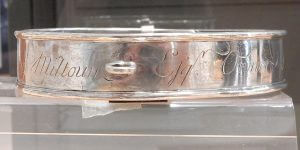
Part of the People’s Palace collection also includes a silver slave’s collar. That ‘Outward Bound’ trade involved shipping goods from Glasgow to the Caribbean where they were sold for sugar and rum which was then transported back to the Clyde, initially to Glasgow’s small sugar houses, but as the trade grew to Greenock.
Glasgow may not have been a slaving port like Liverpool and Bristol, but it boomed on the backs of slaves’ labour. As Dr. Stephen Mullen writes, ‘The limited Scottish role in the direct trade has meant the impact of the plantation economy has been disregarded. The detached nature of what was essentially a trading relationship based on the exploitation of forced labour means that the contribution of the slaves has typically been omitted.’
As the sugar trade grew in importance, so Scots began to emigrate to the Caribbean as ‘sojourners’, taking up positions in plantations as overseers and accountants with the intention of quickly making their fortune. They went to Grenada, Trinidad and [the then British] Guiana, but the largest influx was in Jamaica where, by 1774, an estimated 33% of the white population was Scottish or of Scottish descent.
Back in Glasgow the trade in cotton, sugar, and rum was controlled by a cadre of 37 individuals who, according to Prof. Tom Devine ‘… formed the elite of the trade.’ Their firms: Houstons, John Campbell Sen. & Co, Robert Dunmore & Co., Dennistoun, Buchanan & Co., Leitch & Smith, Robert MacKay & Co., and Stirling, Gordon & Co were significant players in Britain’s sugar trade.
They arranged shipping, the paying of duties, distribution and sales, he acquisition of goods for export and would also extend credit to planters.
With the profits they purchased grand Scottish estates, built grand buildings, and bought respectability, eventually being commemorated in street names.
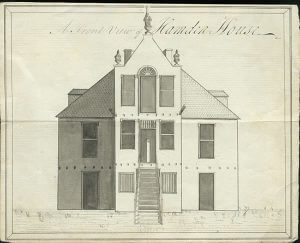
Some also bought plantations. Westerhall in Grenada was one while, as Mullen writes, by 1832 a third of Guiana’s 180 estates were owned by planters with Scottish ancestry.
The name of one Jamaican estate will be familiar to rum drinkers. The Stirlings of Keir and Cadder (and Stirling Gordon) owned the Frontier and Hampden estates. The family website makes interesting reading.
‘Their involvement in Jamaica began in the 18th century. The then head of the family, Sir James Stirling (1679-1749), had 22 children and many were forced to emigrate to support themselves. Several of James’ sons and their descendants went to Jamaica as merchants and planters.
‘The Stirlings had high hopes that their Jamaican estates… would be extremely profitable but the harsh working environment, riots and insurrections [Frontier was where, in 1760, the rebel leader Tacky initiated Jamaica’s first major slave revolt] ensured that the estates were never as profitable as they had expected. The emancipation of slaves which occurred in 1833 quickly made the estates unprofitable.’
What it omits to mention is the compensation which the family was given for its slaves post-emancipation, in 1835. There was the £3,944 for the 229 slaves at Hampden, and a further £8,573 for those at four other plantations. The total would be £1.5million in today’s money. Unprofitable.
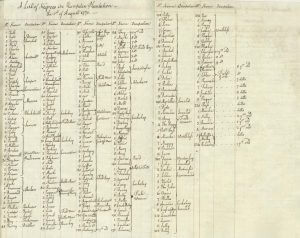
Rum was still being consumed widely. In 1800, almost 680,000 gallons of rum were imported into Glasgow. Its influence stretched wider than the punch bowl however. Throughout the 18th century, rum had established itself as a high quality spirit whose production methods were both innovative and influential. An understanding of the process of cask maturation started with rum.
By the 1850s, rum remained the second-most popular spirit in Scotland (after Irish whiskey). It could be argued that the greater consistency achieved by rum (and Irish whiskey) producers was a stimulus for the creation of blended Scotch.
Wine and spirit merchants had been blending rum for decades before they adapted the same principles to whisky. Rum casks (mostly puncheons) would also have been widely used for the ageing of Scotch.
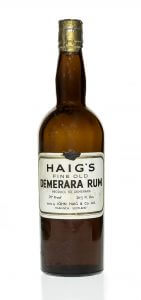
As for the distillation of Scottish rum, the trail goes quiet for most of the 18th century, but a change in the law in 1848 permitted molasses to be used for distillation, along with, ‘grain malted and unmalted, duty paid sugar, potatoes and mangold-wurzel.’
With ever increasing amounts of sugar ending up in the refineries of Greenock there was a mini boom in the mnaking of molasses spirit, peaking in 1862.
But it is the victors who write the history. As rum’s importance declined, so its history as a quality spirit, influence on Scotch, and role in early Scottish distillation was forgotten. More egregiously, the links between Scotland the slave trade were all but excised.
Things are changing and slowly a greater awareness about this chapter in Scotland’s history is being discussed. Finally, the story is being told.
I’ve been asked to join Stephen Mullen and Peter Holland to discuss Scotland’s rum and slavery links as part of the Scottish Rum Fest on Sat 25th July.
References
Devine, T.M. An Eighteenth-Century Business Elite: Glasgow-West India Merchants, c. 1750-1815
Mullen, Stephen The ‘Glasgow West India interest’: integration, collaboration and exploitation in the British Atlantic World, 1776-1846.
Mullen, Stephen, It Wisnae Us
Smout, T.C. The Early Scottish Sugar Houses (1660 – 1720)
Strang John, Glasgow and its Clubs
Trace the history of British slave owning at the UCL website https://www.ucl.ac.uk/lbs/
The Scottish slave trade is here https://it.wisnae.us
An excellent resource on sugar houses is at Bryan Mawer’s site http://home.clara.net/mawer/intro.html My thanks to him
The BBC Scotland film ‘Scotland’s secret Shame’ by Don Coutts and David Hayman is currently available on iPlayer
- The Stirling of Keir archive is held in Glasgow City Archives which is located in the Mitchell Library. Some items referring to Hampden Estate have been digitised https://www.glasgowlife.org.uk/libraries/digital-resources/scotland-s-slavery-past